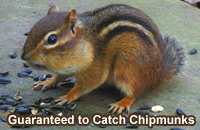Chipmunk Trap
Chipmunks are cute animals. However, like many suburban animals, they can be a nuisance from time to time, just like rats. Chipmunks are notorious for digging up landscape and garden areas. They create burrows in the lawn, and often along rock walls or foundation
walls. They often get inside homes at ground level, looking for a place to nest or store nuts.
Chipmunk Trap was specially designed to trap and remove unwanted chipmunks. It has the highest catch percentage of any chipmunk trap that I have tested. The trap has these special features:
|
- Trap is made of durable wood and withstands any weather.
- Trap is enclosed, ensuring only target chipmunks are trapped, and it is child and pet safe.
- Special scent pan in back holds bait and disperses scent.
- Front entry hole is just the right size and irresistible to chipmunks.
- Clear plexiglass viewing panel allows for easy checking of trap.
- Trap is re-usable and features easy top access to rebait trap and remove
captured chipmunks.
- Safe, easy to use, and works 24/7/365.
|
|
 |

| PRICE: THIS PRODUCT TEMPORARILY DISCONTINUED
We accept all major credit cards and also PayPal.
For phone or check orders, call ###.REMOVED. |
Click the above button to purchase the chipmunk trap. You will be routed to the checkout, where you can pay via credit card, or Paypal account if you have one. The shipping fee is $6.95 for the first trap, and
each additional trap ships free. Some people purchase multiple traps because they see multiple chipmunks on the property, and want the maximum protection. Traps ship next-day from Pennsburg PA, and arrive via USPS Priority mail within 3 days.
We're sorry, but we don't offer international shipping at this time. Only sales to the USA.
Chipmunk Biology and Information
Appearance
They are tiny rodents that are native to continents of Asia and North America. Due to their tiny size, stripes, bushy tails, and large shiny eyes, they look quite identical to squirrels. There are over 25 sub-species of chipmunks, out of which Palmer’s chipmunk is said to be vulnerable in the list of endangered species of International Union for the Conservation of Nature and Natural Resources.
Biology
Distinct from squirrels, chipmunks tend to spend the majority of their time over the ground. Their burrows are complete with various chambers inside it. The tunnels join the chambers. Certain types of chipmunks choose to stay on the trees, in the bushes or among the logs.
Life cycle
The eastern chipmunks are said to mate during early spring and yet again during early summer, thereby producing litters of 4-5 young ones two times every year. The western chipmunks reproduce only one time every year. The young ones come out of the burrow after they turn 6 weeks old and walk out all by themselves within 2 weeks after that.
The chipmunks accomplish numerous significant tasks in forest ecosystems. Their doings such as harvesting and collecting tree seeds actually play a vital function in seeding establishment.
Habitat
There are various attractive features of the life of these small rodents. One particular feature is their habitat. Even though their huge habitat ranges from North America to Asia, the majority of them are discovered in North America. The Siberian Chipmunk, discovered in all parts of Northern Asia, is an exemption though. The habitat of chipmunks in the American continent is wide spread all through different environs, ranging from shrubby deserts to alpine forests, from Mexico in the south to Canada in the north.
Diet
Chipmunks consume an omnivorous diet that consists of nuts, grain, berries, fruits, birds’ eggs, fungi, small frogs, insects and worms and some times, small mammals such as young mice. During the start of autumn, most of the species of chipmunk start to store their food inside their burrows, to ensure that they have enough food to live through the winter season. Other species produce several small reserves of food. Both these type of behavior are known as larder hoarding and scatter hoarding respectively. The larder hoarders typically reside in their nests till spring comes. The cheek pockets permit the chipmunks to transport several food items to the burrows for consumption or storage.
They eat various types of fungi, including the ones that are occupied in symbiotic mycorrhizal connection with the trees. They never need to drink water frequently since they obtain the necessary quantity of water from the food they consume.
Behavior
They are diurnal. They are creatures that spend their time mostly in collecting and stocking up food inside their burrows. The food that is stocked inside their burrow will help them sustain during winter. They have cheek pouches inside which they amass food prior to storing it inside their burrow. Researchers have discovered that a chipmunk can stock almost 6 dozen black-oil sunflower seeds inside its cheek pouches.
|
|
|


